|
|
Updated as per James P. Tuttle's The Hawk Moths of North America, July 2008
|
Natrona County, Wyoming
Sphingidae
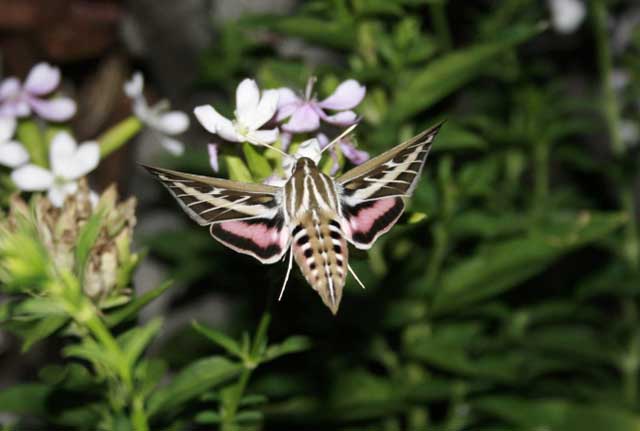
Hyles lineata, Casper, Natrona County, Wyoming,
August 12, 2007, courtesy of Scott Herden.
Please help me develop this list with improved, documented accuracy by
sending sightings (species, date, location), preferably with an
image, via email to
Bill Oehlke.
I do not have confirmed reports of all of these species in Natrona County, but I (WO) expect they are present.
This page is inspired by and dedicated to Scott Herden who sent me the beautiful image
of Hyles lineata, top of page.
Scotty writes, "Taken in Casper, Wyoming. On 8/12/2007.
They visit my friend's yard every year."
Many thanks also to Dwaine Wagoner who has sent me what I am pretty sure are Hemaris diffinis and
Hemaris senta from Casper, Natrona County, Wyoming.
Sphinginae subfamily
Sphingini Tribe:
 |
The upperside of the forewing is pale brownish gray with wavy black and white lines and a black-outlined white cell spot.
The upperside of the hindwing is gray with diffuse darker bands.
|
 |
The costal area in the basal and median areas of the forewing is light grey. This colour also
appears in the terminal area. The rest of the wing is dark slatey grey.
|
 |
Sphinx luscitiosa
WO,
the Canadian Sphinx or
Clemen's Sphinx:
The upperside of the forewing is yellowish gray in males and pale gray with a faint yellow tint in females. In both sexes,
the dark border on the outer margin widens as it approaches the inner margin.
The upperside of the hindwing is deep yellow in males, pale yellow in females; both with a wide black border.
|
 |
The upperside of the forewing has a narrow black subterminal line
bordered by a white inverted V-shaped line on the outside, and a
black line running inwards from the apex of the wing.
It is most often found in montane woodlands and along streamcourses. |
Smerinthini Tribe:
 |
Pachysphinx modesta
WO,
the Modest Sphinx or Poplar Sphinx.
The forewing is grey brown with diffuse lines.
The hindwing is bergundy with dark blue to black markings near the anal angle.
|
 |
This one is quite similar to Pachysphinx modesta, with modesta
being smaller and darker.
Forewing lines are more distinct in P. occidentalis as compared
to P. modesta.
There may be naturally occuring hybrids in Laramie.
|
 |
The grey-blue eyespot of the hindwing gives this species its name.
Larvae feed on birches, willows, cherries and oaks.
The outer edge of the forewings is quite scalloped. |
 |
This small species is widespread and common and is likely present. This species ranges across North America.
The hindwings have a small blue eyespot ringed with black on a yellow background.
|
 |
If you have willows and poplars nearby, you've probably got populations of
the Cerisyi's Sphinx. The hindwings are quite striking.
|
Macroglossinae subfamily
Dilophonotini Tribe
 |
Hemaris diffinis
DW/WO, the
Snowberry Clearwing or Bumblebee Moth
This moth is widespread and is present at least in the northeastern
part of Wyoming. It may fly throughout the state.
|
I am pretty sure the images sent to me by Dwaine Wagoner (bottom of page) are Hemaris diffinis and Hemaris senta.
 |
Hemaris thysbe
WO, the Hummingbird Clearwing
It is not difficult to see why many gardeners would mistake an Hemaris thysbe moth for a small hummingbird as it hovers,
sipping nectar from flowers through a long feeding tube.
|
 |
Hemaris senta
WO/DW,
the Rocky Mountain Clearwing,
There is probably a single brood of this montane species from
May-August. The moth is seen along streamsides and in meadows in
mountainous areas.
|
I am pretty sure the images sent to me by Dwaine Wagoner (bottom of page) are Hemaris diffinis and Hemaris senta.
Macroglossini Tribe
 |
Hyles gallii
WO,
the Bedstraw Hawk Moth or Gallium Sphinx
This forewing is dark brown with a slightly irregular cream-coloured transverse line.
The outer margin is grey. There is a bright pink band on the hindwing.
|
 |
Hyles lineata
SH, the White-lined Sphinx
This species is very widespread. It can be seen flying during the day,
into the evening and also at night.
The highly variable larvae are often found in people's gardens. |
Hyles lineata, Casper, August 12, 2007, Scott Herden.
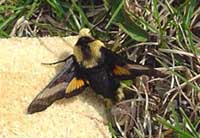 |
Proserpinus flavofasciata
WO, the Yellow-banded Day Sphinx.
The upperside of the forewing is medium to dark brown with a faint to distinct
white median band. The upperside of the hindwing is dark brown with a wide orange median
band which may not reach the inner margin. The moth mimics a bumblebee.
|
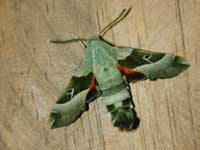 |
The upperside of the forewing is pale gray-green with a deep
green-brown median area and a white dash at the wing tip.
|
Proserpinus juanita larva, Casper, July 23, 2009, courtesy of Dwaine Wagoner.
|
|
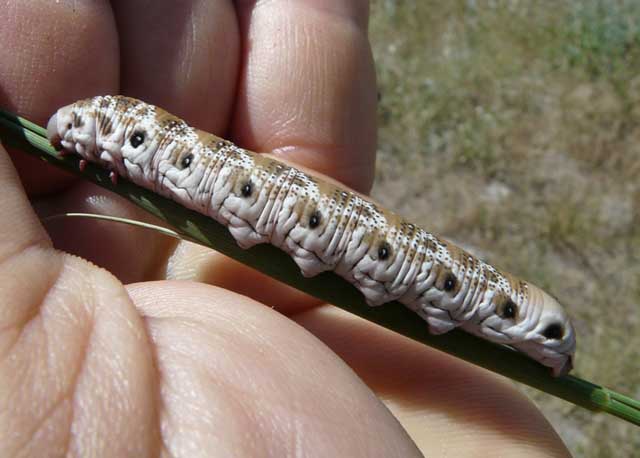
Proserpinus juanita, Casper, Natrona County, Wyoming,
July 23, 2009, courtesy of Dwaine Wagoner.
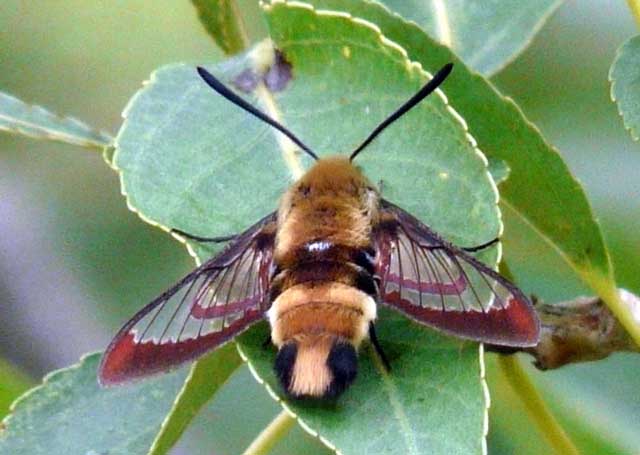
Hemaris diffinis, Casper, Natrona County, Wyoming,
August 1, 2008, courtesy of Dwaine Wagoner, tentative id by Bill Oehlke.
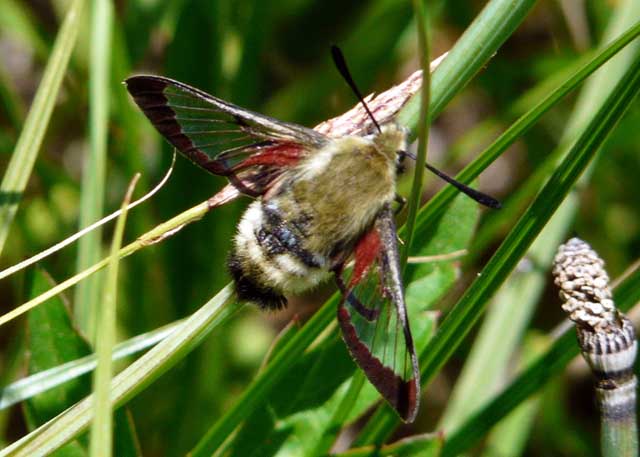
Hemaris senta, Casper, Natrona County, Wyoming,
August 1, 2008, courtesy of Dwaine Wagoner, tentative id by Bill Oehlke.
I am confident the upper of the two Hemaris species is H. diffinis, based on black legs
and yellow brown thorax and abdomen. Images of both moths were taken on same approximate date from same immediate area.
I do not have a good view of the ventral surface of either moth. The legs and under side (abdomen) of
H. senta are supposed to be yellowish, while the legs of diffinis are black and there is some black on the underside of the abdomen.
The thorax of senta tends to be greenish (some digital repair (hair replacement) by Bill oehlke).
Use your browser "Back" button to return to the previous page.
This page is brought to you by
Bill Oehlke and the
WLSS. Pages are on space rented from Bizland. If you would like
to become a "Patron of the Sphingidae Site", contact Bill.
Please send sightings/images to Bill. I will do my best to respond to
requests for identification help.
Enjoy some of nature's wonderments: Saturniidae cocoons. Cocoons of these
giant silkmoths are for sale in fall and winter. Large, beautiful moths emerge in the spring and summer.
 | 
Show appreciation for this site by clicking on flashing butterfly to the left.
The link will take you to a page with links to many insect sites. |





